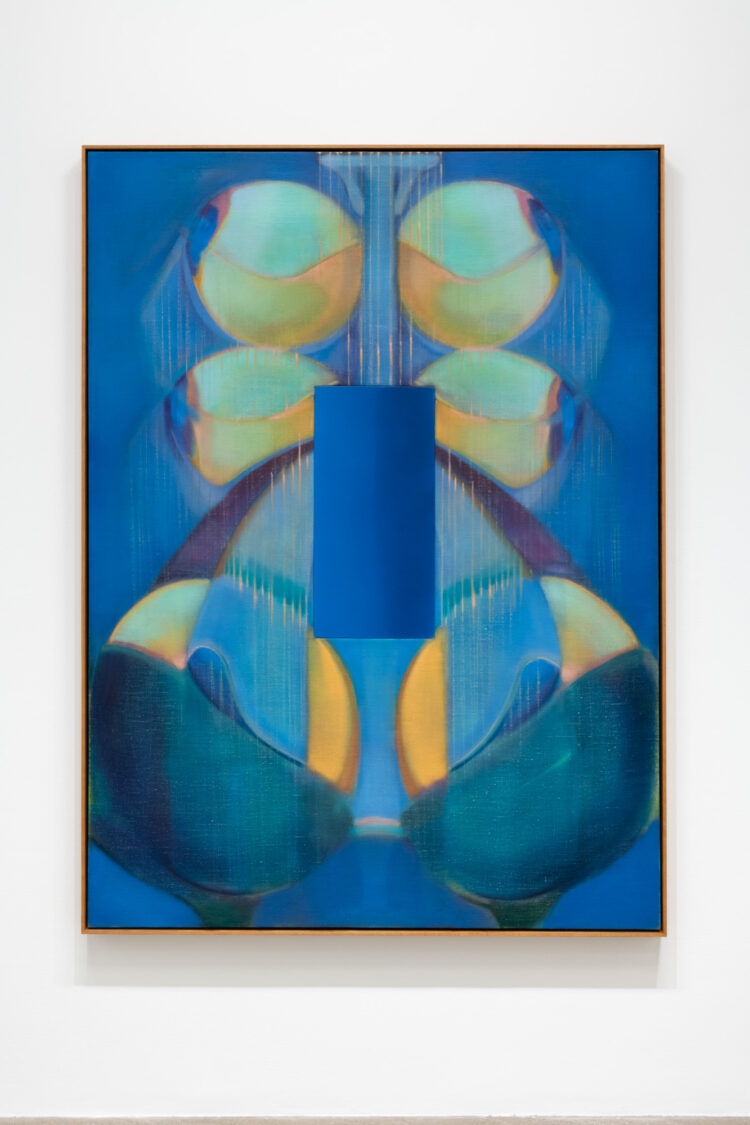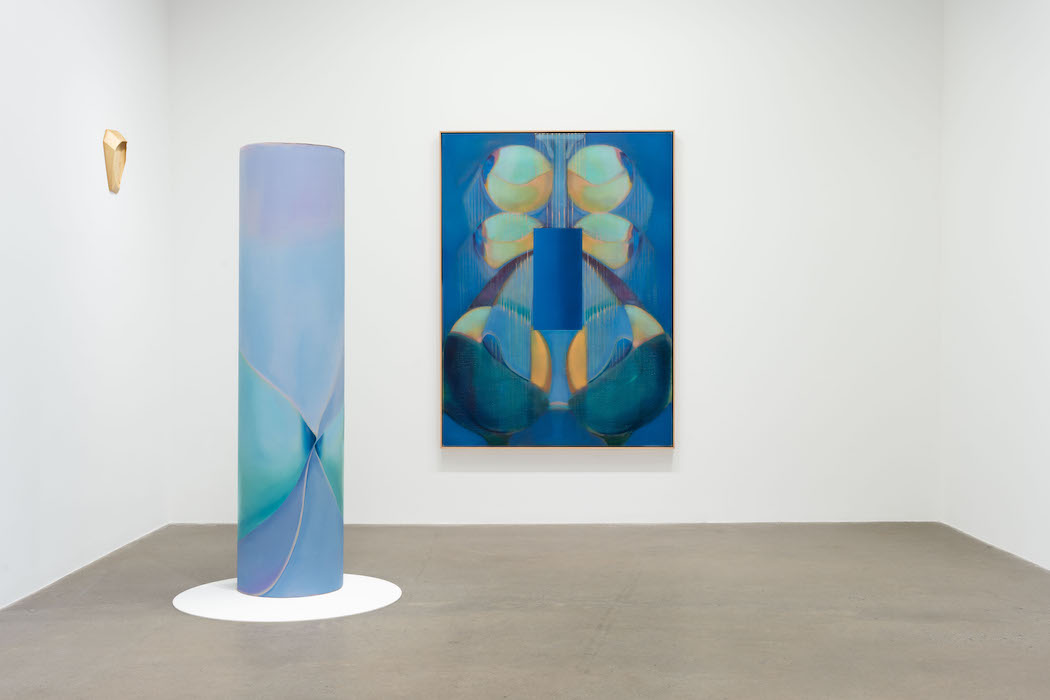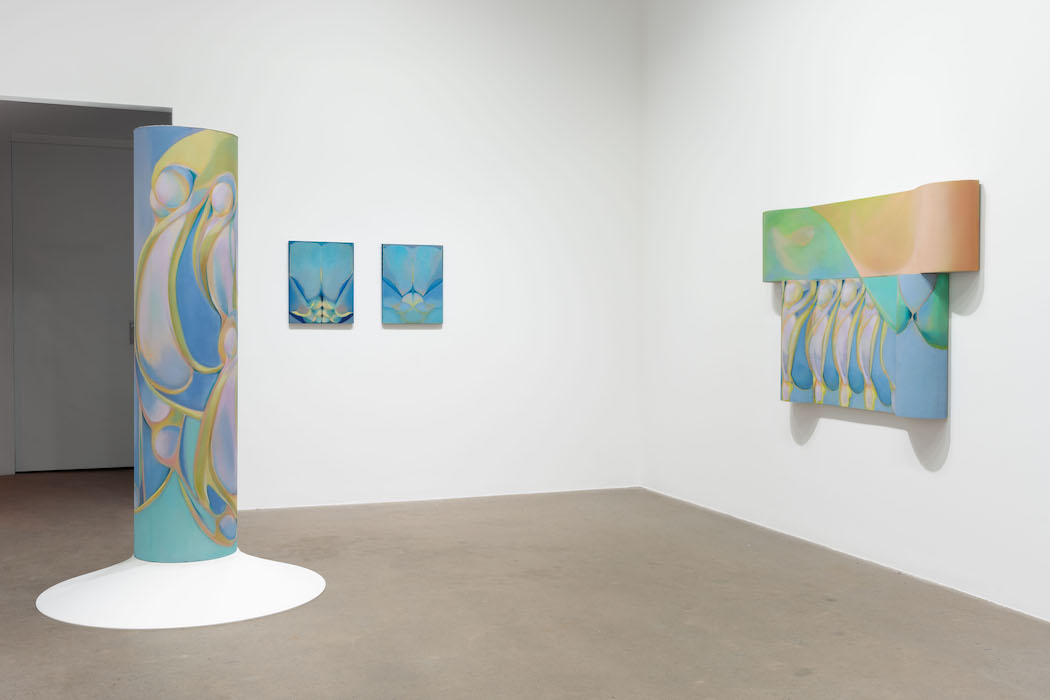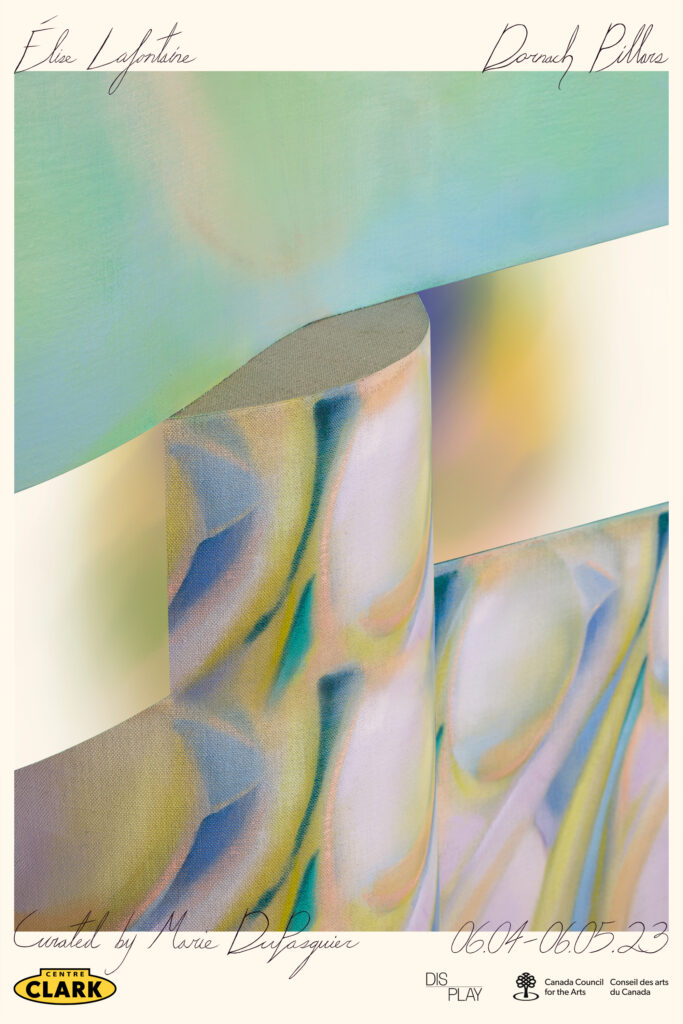DORNACH PILLARS
ÉLISE LAFONTAINE
Opening
Opening, April 6, 6pm
Exhibition
Exhibition, April 6 – May 6, 2023
Location
Centre Clark
5455, Avenue de Gaspé, Suite 114, Montréal, Canada

We are grateful to have been invited to accompany Elise Lafontaine on her exhibition Dornach Pillars at Centre CLARK in Tiothiá:ke / Montreal (QC), Canada, and to have contributed with a text.
> version française ci-dessous
DORNACH PILLARS
Eyes wide open, head down, hanging by a foot, one leg bent – the figure of the hanged man appears. Despite the ambiguity of this major arcana of the tarot, the soft gaze seems to convey self-determination, intuition and great concentration. The gaze towards the inner core. Through reversal, the card invites to go past a heritage of illusions and projections, to lose one’s own reference points in favor of a change of perspective.
This impression of bewilderment, the distance from the familiar, or at least the disruption of a balance that weakens a certain established order, seems to be sought by Élise Lafontaine as she enters closed spaces. Identifiable edifices, their representative and functional architecture covers a reality of their own and excludes sometimes their community from society. These spaces were built to contain, confine or isolate. Prisons, psychiatric hospitals, caves or monasteries – they hold power and knowledge, belief systems, sustained by the State, or spiritual and ideological institutions. Like the Goetheanum in Dornach, Switzerland, which Élise Lafontaine visited last – a structure constructed to be a total “embodiement” of the anthroposophical thought.
The recognition of the site passes by processes of identification and anchoring to perhaps end in a kind of communion. Like a pendulum, the artist takes the measure of the architectural and vibratory space, immerses herself in its spatiality, oscillating between perception and sensation until she abolishes the distance between them: “the strange sensory experience contributes to a feeling of dissociation from reality and the movements of my limbs fill the space in a disproportionate scale ratio[1].” An amplified corporality reaches the frescoes of the vaults, sonorities come to fill the memorial gaps, its permeable membranes absorb the surrounding tints. Élise Lafontaine captures the carrier system as well as the infiltrating light rays. Her body, activated by the pictorial gesture, becomes a “synesthetic commutator[2]“. It is the vehicle allowing the translation, like a delicate transfer of relics, of which the Latin root translatio indicates both the transport and the translation. To these “remains” is added a quantity of metaphysical and mystical information, invisible and intangible.
From each visited location, characteristics are added to the paintings. Here, curves and columns structure the marouflaged canvases. Female organs, entrails of concrete – their representativeness is not confined to a single register, nor to their affinity with the works of pioneers of abstraction such as Hilma af Klint (1862-1944) or of concrete art such as Zilia Sánchez (1926). The layers of sandblasted paint reveal the armature of silhouettes, as though filtered by bioluminescent gleams. They are presences. Like the “women statues[3]”, the column paintings of Élise Lafontaine indicate the entrance as much as they redefine the exhibition space – another circumscribed place – as a passage.
If the canvases function as a device of monstration and orientation, Élise Lafontaine reverses them. In the process, she turns her paintings upside down and thus plays with directions, as if to distance herself from the inhabited places or to emancipate herself from identifiable forms. In doing so, she lays the moving foundations of another architecture, born of disorientation : “Disorientation opens a space of difference, between here and there, public and private, profane and sacred, strange and familiar, and so on[4]”.
Marie DuPasquier
[1] Élise Lafontaine, Archives, Centre d’art et de diffusion CLARK, 2023, p. 50, about her experience at the Lombrives Cave, France.
[2] Sara Petrucci, « Le corps et la géométrie. Visualisations et transformations », in Nombres, rythmes, transformation. Dialogue contemporain avec Emma Kunz, Göttingen : Steidl, 2020 p.62, after Arnauld Pierre.
[3] Agnès Varda, Les dites cariatides, film, 35mm, color, 13 min, 1984.
[4] Marcella Schmidt di Friedberg, Geographies of disorientation, New York: Routledge, 2018, p.3, quoting Bernard Stiegler.
Élise Lafontaine (Tiohtià:ke/Montreal, Canada) holds a master’s degree in visual and media arts from the Université du Québec à Montréal (2020) and a BFA from Concordia University (2015). She has participated in artist residencies at the Fondation Christoph Merian / CALQ and Malévoz Quartier culturel (Switzerland), at the Vermont Studio Center (United States), and at Leipzig International Art Programme (Germany). Her work has been presented in solo exhibitions at Sothu Zurich (Switzerland) and at Pangée and Galerie Nicolas Robert (Canada), and in group exhibitions (Centre CLARK, Fondation Rad Hourani, McBride Contemporain, Maison de la culture du Plateau‑Mont‑Royal, Usine C, Galerie Art Mûr, Leipzig Spinnerei Autumn Gallery Tour). In 2023, the Centre CLARK (Canada) will publish her first book Archives where she will present a solo exhibition with guest curator Marie DuPasquier (Zurich and Berlin). In the fall, she will participate in a group exhibition at Soka Art Beijing (China) curated by Jessica Wan (Hong Kong and London). Lafontaine is represented by Pangée.
To read: Élise Lafontaine interview for artfridge.de
DORNACH PILLARS
Les yeux grands ouverts, tête en bas, suspendu par un pied, une jambe repliée, la figure du pendu apparaît. Malgré l’ambiguïté de cet arcane majeure du tarot, son regard doux semble convier l’autodétermination, l’intuition, la prise de décision et une grande concentration. Le regard porté vers l’intérieur. Par le renversement, la carte invite au dépassement d’un héritage d’illusions et de projections, à la perte de ses propres repères en faveur d’un changement de perspective.
Cette étrange sensation de déboussolement, l’éloignement du familier, ou du moins la rupture d’un équilibre qui fragilise un certain ordre établi semble déjà recherchée par Élise Lafontaine lorsqu’elle s’introduit dans des lieux clos. Édifices reconnaissables et localisés, leur architecture représentative et fonctionnelle recouvre une réalité qui leur est propre et écarte parfois sa communauté de la société. Ces lieux contiennent, confinent ou isolent. Centres carcéraux, hôpitaux psychiatriques, grottes ou monastères – ils détiennent pouvoir et savoir, systèmes de croyance, qu’ils soient étatiques, spirituels ou idéologiques. C’est le Goetheanum à Dornach, en Suisse, érigé pour incarner de manière totale la pensée anthroposophique, que visite Lafontaine en dernier.
Devenue méthodique, la reconnaissance du lieu passe par l’identification, l’ancrage, la rencontre de physicalités et de personnalités dont l’issue serait une sorte de communion. Comme un pendule, l’artiste prend la mesure de l’espace architectural et vibratoire, s’immisce dans sa spatialité. Elle oscille ainsi entre perception et sensation jusqu’à abolir la distance qui les séparent : « l’étrange expérience sensorielle contribue à un sentiment de dissociation de la réalité et les mouvements de mes membres remplissent l’espace dans un rapport d’échelle disproportionné »[1]. Une corporalité amplifiée atteint les fresques des voûtes, des sonorités viennent combler les lacunes mémorielles, ses membranes perméables absorbent les teintes environnantes. Elise Lafontaine, capte le système porteur aussi bien que l’infiltration de rayons lumineux. Son corps alors activé par le geste pictural se fait « commutateur synesthésique[2]». Il devient le véhicule permettant la translation, comme ce délicat transfert de reliques, dont la racine latine du terme translatio indique à la fois le transport et la traduction. À ces « restes » s’ajoutent une quantité d’informations métaphysiques et mystiques, invisibles et intangibles.
À partir de chaque lieu visité, des caractéristiques viennent compléter les peintures. Ici, courbes et colonnes dessinent la structure même des toiles marouflées et confirment les qualités organiques et architectoniques des peintures. Organes féminins, entrailles de béton – leur représentativité ne se laisse pourtant pas cloisonner dans un seul registre, ni dans leur affinité avec les travaux de pionnières de l’abstraction telle que Hilma af Klint (1862-1944) ou de l’art concret telle que Zilia Sánchez (1926). Les couches de peinture sablées laissent apparaître l’armature de silhouettes, comme filtrées par des lueurs bioluminescentes. Ce sont des présences. Telles les « femmes statues[3] », les colonnes-peintures d’Élise Lafontaine indiquent l’entrée autant qu’elles redéfinissent l’espace d’exposition – autre lieu circonscrit – en lieu de passage.
Si les toiles fonctionnent comme un dispositif de monstration et d’orientation, Élise Lafontaine les renverse. Elle retourne ses peintures en cours de processus et se joue ainsi des directions, comme pour se distancer des lieux habités, ou bien pour s’affranchir de formes identifiables. Par là même sont posées les fondations mouvantes d’une architecture autre, née de la désorientation : « La désorientation ouvre une différence, entre ici et là-bas, public et privé, profane et sacré, étrange et familier, etc.»[4].
Marie DuPasquier
[1] Elise Lafontaine, « Archives », 2023, p. 50 à propos de son expérience dans la Grotte de Lombrives, France
[2] Sara Petrucci, « Le corps et la géométrie. Visualisations et transformations » dans Nombres, rythmes, transformation. Dialogue contemporain avec Emma Kunz, Göttingen : Steidl, 2020, p.62, selon la formule d’Arnauld Pierre.
[3] Agnès Varda, Les dites cariatides, film, 35mm, couleur, 13 min, 1984
[4] Marcella Schmidt di Friedberg, « Goegraphies of disorientation », New York : Routledge, 2018, p.3 (citant Bernard Stiegler)
Élise Lafontaine (Tiohtià:ke / Montréal, Canada) détient une maîtrise en arts visuels et médiatiques de l’Université du Québec à Montréal (2020) et un baccalauréat en arts visuels de l’Université Concordia (2015). Elle a participé à des résidences d’artistes à la Fondation Christoph Merian / CALQ et à Malévoz Quartier culturel (Suisse), au Vermont Studio Center (États‑Unis) ainsi qu’au Leipzig International Art Programme (Allemagne). Son travail a été présenté dans le cadre d’expositions solos à Sothu Zurich (Suisse), à Pangée et à la galerie Nicolas Robert (Canada) ainsi que dans des expositions collectives (Centre CLARK, Fondation Rad Hourani, McBride Contemporain, Maison de la culture du Plateau‑Mont‑Royal, Usine C, galerie Art Mûr, Leipzig Spinnerei Autumn Gallery Tour). En 2023, le Centre CLARK (Canada) publiera son premier livre Archives où elle y présentera une exposition individuelle en compagnie de la commissaire invitée Marie DuPasquier (Zurich et Berlin). À l’automne, elle participera à une exposition de groupe à Soka Art Beijing (Chine) commissariée par Jessica Wan (Hong Kong et Londres). Lafontaine est représentée par Pangée.
1) Image: Élise Lafontaine Dornach pillars, 2022, Oil on linen over wood panel, 40 × 60 × 5 1/2 in | 101.6 × 152.4 ×
14 cm. Crédit photo: Alignement
2) Poster: Design Antoine Thériault


The Great Tower, 2023 © Élise Lafontaine, Photo: © Paul Litherland



Jeux de fond ( The flutes), 2023, 50,80 x 55 x 8,89 cm, oil on linen mounted on volumetric wood, © Élise Lafontaine, Photo © Document original

Ear handle, 2023, wood – hand carve (Reproduction of a bronze handle at the Goetheanum) © Élise Lafontaine, Photos © Paul Litherland

“Dornach Pillars,” Exhibition View at Centre CLARK, 2023, © Élise Lafontaine, Photo © Alignements
